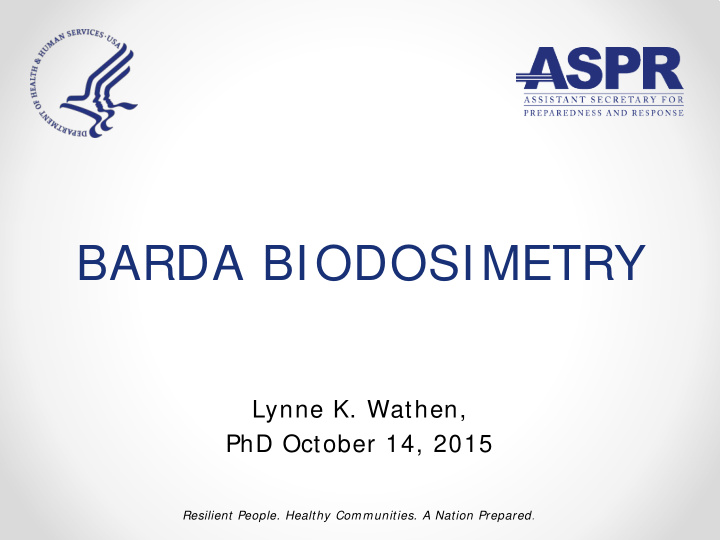



BARDA BIODOSIMETRY Lynne K. Wathen, PhD October 14, 2015 Resilient People. Healthy Communities. A Nation Prepared.
BARDA Biodosimetry Desired Throughput Medical Evaluations & Care Follow on Point of Care Screening ≥ 2 Gy Plus ( 1 M people) < 2 Gy Care High Throughput Screening - ( 4 0 0 ,0 0 0 people) 2
Target Product Profiles Point of Care Device High Throughput Device ( POC) ( HT) Quantitative (accuracy ± 0.5Gy) Type of result: Qualitative CONOPs: Initial Triage / Sorting Injury Assessment / Treatment Tool Exposure level: 2 Gy - threshold Range: 0.5 – 10 Gy Ease of operation: Easy to operate, minimal Laboratory instrument—more labor complexity, requires minimal intensive, requires training training, CLIA waived Device Integrated components—no May include separate components as Characteristics: separate sample preparation needed. High automation desired. Intended use: Tents, shelters, open settings Labs, hospitals, fixed facilities # Patients / Event Up to 1,000,000 within 6 days Up to 400,000 within 7 days (may need multiple assessments) Time to result: Rapid but individual sample result Up to 24 hours (15 to 30 minutes)
Point of Care Biodosimetry Programs Estim ated Point Of Care Results per Developer Type Technology Day per I nstrum ent Protein Expression Dual Lateral Flow w/ immunoassay Reader & Cell Extractor 400 Protein Expression Microfluidic Cartridge & 72 immunoassay Instrument
High Throughput Laboratory Biodosimetry Programs HT Autom ation Estim ated Technology Results per Developer Day per I nstrum ent Gene Semi-automated including ABI 3500 500 Duke/ DxTerity expression Dx Northrop Semi-automated including Applied Cytology – Grumman/ 1200 Spectral Imaging Cytology Applied Spectral micronuclei Microscopes Imaging Semi-automated including ABI Arizona Gene 700 7500Dx or Life technologies State expression University QuantStudio 5
BARDA Broad Agency Announcement Number: CBRN-BAA-1X-100-SOL-0001X Biodosim etry Diagnostic Areas of I nterest ( AOI ) 6.1 Development of a dosim etry self-assessm ent tool in order to determine if an individual has been exposed to ionizing radiation at a dose equal to or greater than 2 Gy. 6.2 Biodosimetry Systems: BARDA is interested in advanced developm ent of a rapid point- of-care diagnostic assay for assessing whether an individual’s absorbed dose of ionizing radiation was above or below 2 Gy, and/ or a centralized high-throughput assay system for determining absorbed doses of ionizing radiation in the range of 0.5 Gy to 10 Gy, that have a robust detection signal from 24 hours post-exposure which persists at least one (1) week. Minim um technology readiness: TRL-6 . 6.3. Development of an im provem ent on the current “gold standard” for assessing absorbed doses of ionizing radiation ( the dicentric chrom osom al assays (DCA)) in terms of ease of use, time for performance, statistical certainty of dose, improved dose range, and biomarker lifespan.
6.2 Advanced Biodosimetry Systems White papers must at a minimum include: • Listing of radiation responsive marker(s) and performance data in human and an animal model for each of them. • Evidence that a pre-submission meeting has been held with the FDA • Instrument and consumable definition and performance data of key components or entire system. • Listing of all key team members, identifying who will fill each key skill needed to develop, manufacture, and achieve regulatory approval of the product. • Functional prototype instrument and consumables in final form. 7
Recommend
More recommend